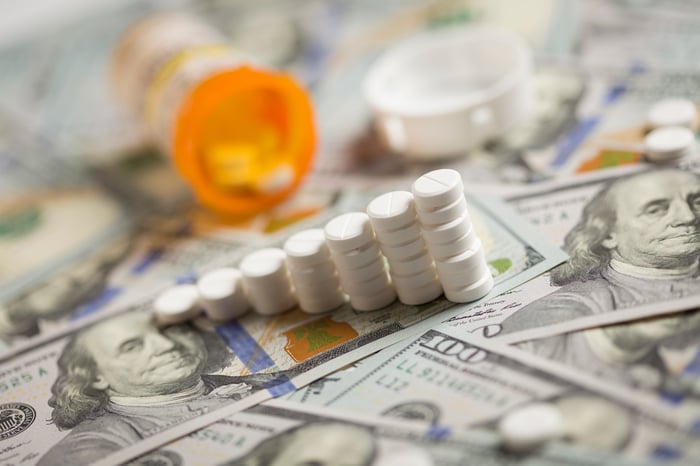Though there are a lot of ways to make money on Wall Street, buying dividend stocks has been about as surefire a strategy as they come. Dividend-paying companies are often profitable, time-tested, and most importantly have run circles around non-dividend payers over the long run.
Back in 2013, J.P. Morgan Asset Management released a report that compared the average annual return of companies initiating and growing their payouts between 1972 and 2012 to companies that didn't offer a dividend over the same time frame. In total, the dividend-paying stocks averaged a 9.5% annualized return over four decades, compared to a meager 1.6% annualized return for the non-dividend stocks.
While there are no shortage of dividend stocks for income investors to choose from, the following five companies are truly in a league of their own. You see, on a combined basis, they're parsing out $71 billion in dividend income annually to their shareholders.

Image source: Getty Images.
Microsoft: $18.62 billion
No publicly traded company in the U.S. is going to pay out a larger dividend over the coming 12 months than software kingpin Microsoft (MSFT 0.37%). Based on its $2.48 base annual payout, Microsoft is rewarding its shareholders with $18.6 billion in dividend income. Yet in spite of this market-leading payout, Microsoft's dividend yield is only 0.9%.
There are three factors that have made Microsoft such an overwhelming success story for long-term investors. First, the company's legacy operations remain cash cows. Microsoft is never going to see the growth from its Windows franchise that it saw two decades ago, but it continues to be the undisputed leading operating system for personal computers.
Secondly, Microsoft is benefiting from aggressive investments in cloud computing. Cloud infrastructure service Azure registered 51% year-over-year sales growth in Microsoft's fiscal fourth quarter, and has settled in as the second largest cloud infrastructure service by global revenue share. Cloud services offer juicy margins that help generate abundant cash flow.
Thirdly, Microsoft's copious cash flow has allowed the company to make a number of acquisitions. Even though these buyouts don't always work as intended, more often than not they've lifted Microsoft's earnings potential.

Image source: Getty Images.
ExxonMobil: $14.72 billion
Income investors might not be cozying up to oil stocks in 2021 the same way they were prior to the coronavirus pandemic, but integrated oil and gas giant ExxonMobil (XOM 0.02%) continues to be a gusher on the dividend front. Over the coming 12 months, shareholders will receive a little over $14.7 billion in dividend income.
One reason ExxonMobil has been such a steady income stock for so many decades is its integrated operating model. The beefiest margins for the company come from its upstream assets, which drill for oil and natural gas. However, the company's downstream assets -- refineries and petrochemical plants --hedge against moves lower in the price of crude. When the price for crude oil declines, input costs for refiners and chemical plants drop, too. This hedge ensures that ExxonMobil is almost always generating positive operating cash flow.
Prudent fiscal management is another reason ExxonMobil has been a dividend stud. Though it takes tens of billions of dollars in annual spending to develop oil, natural gas, and natural gas liquids projects worldwide, ExxonMobil has the capacity to open and close its capital expenditures spigot to match prevailing economic conditions. Paring back its capex in 2021 creates additional cushion for the company to continue paying out its above-average yield of 5.9%.

Image source: Apple.
Apple: $14.55 billion
If you thought Microsoft's 0.9% yield is tiny, Apple's (AAPL 1.27%) 0.6% yield probably sounds microscopic. However, this is more a function of Apple's share price rocketing higher over time than of Apple failing to look after its investors. Since initiating a quarterly dividend in 2012, Apple's payout has increased by 132%. In total, Apple's $0.88 base annual payout equates to the company handing out $14.55 billion to its shareholders over the next year.
The largest publicly traded company in the U.S. has thrived as a result of its brand recognition and innovation. The iPhone is the most-popular smartphone device in the U.S., and new product launches are regularly met by lines wrapping around Apple's stores. The introduction of a 5G-capable iPhone late last year should lead to a multiyear device upgrade cycle that continues to pad Apple's pockets.
The other exciting development for Apple is its steady push to become a service-focused company. CEO Tim Cook is overseeing this transition, with Apple emphasizing higher-margin subscription services and wearables. This transformation should ultimately reduce the revenue lumpiness associated product replacement cycles, as well as lift operating cash flow.

Image source: Getty Images.
JPMorgan Chase: $11.96 billion
Another big-time dividend payer that income investors can "bank" on is money-center bank JPMorgan Chase (JPM 0.49%). After announcing an 11% quarterly dividend hike in late June, this pillar of banking stability is on track to hand out almost $12 billion in dividend income over the next 12 months.
The cyclical nature of banking is one factor that allows JPMorgan Chase to be such a prominent income stock. Although economic contractions and recessions are inevitable, they usually only last a few months to a couple of quarters. By comparison, virtually all economic expansions are measured in years. Since bank stocks spend far more time in the sun than the shade, they're able to pass along hefty payouts.
JPMorgan Chase is also benefiting from its omnichannel presence. It's been actively investing in digitization initiatives to promote online and mobile banking, and unlike its peers has been expanding its physical branches into new markets. Having multiple avenues to connect with consumer and enterprise clients is a winning proposition.
As one final point, JPMorgan Chase CEO Jamie Dimon has done a remarkably good job of steering his bank clear of riskier derivative investments in his nearly 15 years at the helm. By focusing on the bread-and-butter of banking (i.e., loan and deposit growth), JPMorgan Chase has been able to deliver hearty shareholder returns.

Image source: Getty Images.
Johnson & Johnson: $11.15 billion
Last, but not least, healthcare conglomerate Johnson & Johnson (JNJ -0.69%) has just what the doctor ordered: an $11.15 billion annual payout to shareholders. This coming April, J&J will almost certainly be increasing its base annual payout for the 60th consecutive year. Only a handful of publicly traded companies in the U.S. have a longer active streak of increasing their annual dividend.
To begin with, Johnson & Johnson is a success because it operates in the highly defensive healthcare sector. No matter how well or poorly the U.S. economy or stock market are performing, people still get sick and require healthcare services, pharmaceuticals, and medical devices. This creates a predictable demand floor for nearly all healthcare stocks, including J&J.
Johnson & Johnson's long-term outperformance is also a function of its three operating segments bringing something important to the table. For example, even though the company's consumer healthcare products segment is its slowest-growing, it provides highly predictable cash flow and strong pricing power. Meanwhile, medical device growth is modest now, but should pick up considerably as the global population ages. Finally, pharmaceuticals provides the bulk of J&J's growth and margins. However, brand-name drugs have a finite period of sales exclusivity. These segments all work together to generate copious amounts of operating cash flow for J&J.





